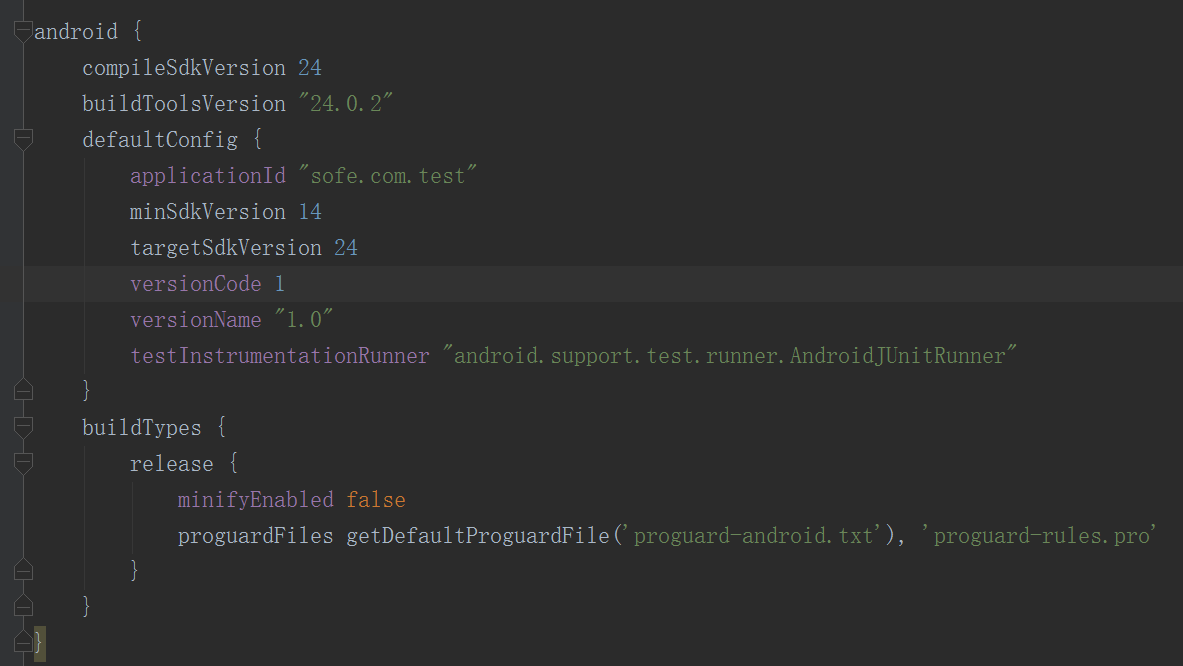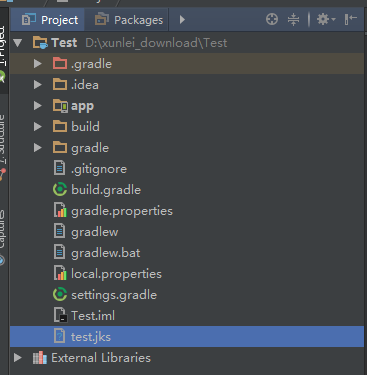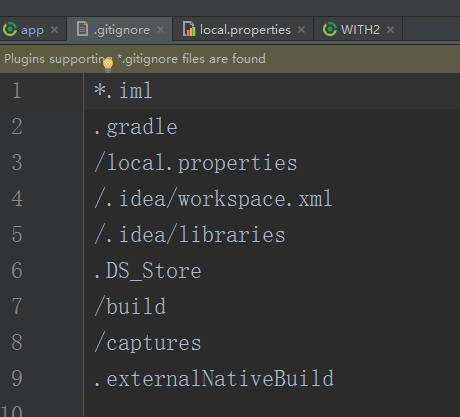Android studio之簽名配置
在上一篇教程中,我講解了Android studio多渠道打包的相關配置,在這一篇部落格中,我們將繼續講解Android studio的簽名配置。如果還沒有看過上一篇的朋友,或者還不瞭解多渠道打包的,可以先看這一篇部落格
Let’s go,讓我們開始新的教程。
我們可以新建一個專案,然後生成一個新的簽名檔案。
一般來說,經過這些操作之後,我們便可以通過點選左上角的Build->Generate Signed APK->Next,然後選擇對應的Build Type進行打包。
那對一些人來說,這樣也太麻煩了,每次都得輸入相關資訊,還得進行選擇,這怎麼能忍!
那麼有更簡單快捷的方法嗎?答案是有的。
我們可以在專案的app目錄下的build.gradle中進行簽名的配置。
首先我們找到build.gradle下的android{},預設配置如下所示
接下來呢,我們可以把專案的預覽模式調成Project,不調也行,只需把剛才生成的簽名檔案放至到對應的目錄下即可。我的做法是直接放至到專案下,如圖所示
然後,回到app下的build.gradle,在裡面增加這段程式碼
signingConfigs {
debug {
storeFile file('../test.jks')//簽名檔案路徑
storePassword "123456" 我來解釋一下,storeFile file對應的就是簽名檔案key的路徑,我們的簽名放在專案的直接子路徑下,而build.gradle在test/app下,所以我們要用 .. 找到專案的根路徑,再通過 / 找到對應的簽名檔案所在路徑。當然,你也可以自己配置簽名檔案的地址,只要能找到即可。
此時,我們在專案路徑下的app/build/outputs可以看到我們打包的apk,從名字可以看出,該APK是已經簽名的。那麼就是說,用程式碼配置,可以達到和使用圖形介面一樣的效果。
對了,這裡有一點需要注意,就是signingConfigs程式碼塊一定要寫在buildTypes前面,否則會報下面這種錯: Could not find property ‘debugConfig’ on SigningConfig container.
至此,我們的buildTypes的配置可以這樣:
buildTypes {
debug {
println("====== buildTypes.debug ======")
signingConfig signingConfigs.debug
}
release {
//是否混淆
minifyEnabled false
//是否移除無用資源
zipAlignEnabled true
println("====== buildTypes.release ======")
signingConfig signingConfigs.release
//混淆的配置檔案
proguardFiles getDefaultProguardFile('proguard-android.txt'), 'proguard-rules.pro'
}
}大家現在便可以通過命令列進行任意操縱,或者進行多渠道打包。
不過,上述的配置雖然配置簡單,但是存在不安全性,假如你的專案是開源的,你把簽名檔案的配置密碼之類的資訊用明文寫在build.gradle裡面,那是不是很不安全呢?
所以,我們可以這麼做。在專案路徑下新建一個.properties的檔案,或者直接local.properties下直接新增相關資訊即可。
我們可以直接在該檔案下新增:(填寫相關資訊)
keystore.path=../test.jks //替換成自己的簽名路徑
keystore.password=123456
keystore.alias=test
keystore.alias_password=123456那麼,在build.gradle下面,為了不用明文顯示,我們首先要獲得key的相關配置,所以我們可以在app的build.gradle下面新增該程式碼
def keystoreFilepath = ''
def keystorePSW = ''
def keystoreAlias = ''
def keystoreAliasPSW = ''
// default keystore file, PLZ config file path in local.properties
def keyfile = file('s.keystore.temp')
Properties properties = new Properties()
// local.properties file in the root director
properties.load(project.rootProject.file('local.properties').newDataInputStream())
keystoreFilepath = properties.getProperty("keystore.path")
if (keystoreFilepath) {
keystorePSW = properties.getProperty("keystore.password")
keystoreAlias = properties.getProperty("keystore.alias")
keystoreAliasPSW = properties.getProperty("keystore.alias_password")
keyfile = file(keystoreFilepath)
}首先,便是給key賦預設值,然後根據Properties的配置檔案,然後根據我們在local.properties下的配置引數keystore.password等獲取簽名檔案的配置資訊。
這裡有一點需要強調,在git版本控制的專案中,我們可以看到我們專案下有一個.gitignore的檔案,裡面的配置大概如下所示
我們可以看到/local.properties,意思就是說local.properties預設是不新增到版本控制裡面的,因為local.properties儲存的是我們環境資源的一些相關資訊,如sdk的路徑。故我們可以在local.properties下配置簽名信息而不用擔心金鑰外洩。對於開源專案來說,是非常好的。
那麼,此時此刻,我們app/build.gradle下的signingConfigs可以改為:
signingConfigs {
debug {
storeFile keyfile
storePassword keystorePSW
keyAlias keystoreAlias
keyPassword keystoreAliasPSW
println("====== signingConfigs.debug ======")
}
myConfig {
storeFile keyfile
storePassword keystorePSW
keyAlias keystoreAlias
keyPassword keystoreAliasPSW
println("====== signingConfigs.release ======")
}
}相應的,buildTypes也可以配置成這樣
buildTypes {
debug {
println("====== buildTypes.debug ======")
signingConfig signingConfigs.debug
}
release {
//是否混淆
minifyEnabled false
//是否移除無用資源
zipAlignEnabled true
//混淆配置
proguardFiles getDefaultProguardFile('proguard-android.txt'), 'proguard-rules.pro'
//簽名檔案存在,則簽名
if (keyfile.exists()) {
println("WITH -> buildTypes -> release: using jks key")
signingConfig signingConfigs.myConfig
}else {
println("WITH -> buildTypes -> release: using default key")
}
applicationVariants.all { variant ->
variant.outputs.each { output ->
def outputFile = output.outputFile
if (outputFile != null && outputFile.name.endsWith('.apk')) {
// 輸出apk名稱為ruijie_v1.0_wandoujia.apk
def fileName = "ruijie_v${defaultConfig.versionName}_${variant.productFlavors[0].name}.apk"
output.outputFile = new File(outputFile.parent, fileName)
}
}
}
}這樣的話,當我們的專案是開源的,那麼我們不會上傳簽名檔案,我們通過上述程式碼keyfile.exists()進行判斷是否有簽名,那麼其他人打包出來的apk是未簽名的。所以能夠保證apk簽名的安全性。
附加一下:build.gradle的相關配置:
有時候我們打包會顯示lint報錯,那麼我們可以新增
lintOptions {
abortOnError false
}dx工具(android將jar包轉成dex格式二進位制jar包工具)
這將應用所有使用dex的task。解決65535的配置
dexOptions {
incremental true
javaMaxHeapSize "4g"
//關閉預編譯
preDexLibraries = false
}或者指定JDK的編譯版本
compileOptions {
sourceCompatibility JavaVersion.VERSION_1_8
targetCompatibility JavaVersion.VERSION_1_8
}打包忽略掉第三方jar相同的檔案
packagingOptions {
exclude 'META-INF/DEPENDENCIES.txt'
exclude 'META-INF/LICENSE.txt'
exclude 'META-INF/NOTICE.txt'
exclude 'META-INF/NOTICE'
exclude 'META-INF/LICENSE'
exclude 'META-INF/DEPENDENCIES'
exclude 'META-INF/notice.txt'
exclude 'META-INF/license.txt'
exclude 'META-INF/dependencies.txt'
exclude 'META-INF/LGPL2.1'
}最後,附上build.gradle部分配置的相關程式碼:
apply plugin: 'com.android.application'
apply plugin: 'me.tatarka.retrolambda'
apply plugin: 'android-apt'
def keystoreFilepath = ''
def keystorePSW = ''
def keystoreAlias = ''
def keystoreAliasPSW = ''
// default keystore file, PLZ config file path in local.properties
def keyfile = file('s.keystore.temp')
Properties properties = new Properties()
// local.properties file in the root director
properties.load(project.rootProject.file('local.properties').newDataInputStream())
keystoreFilepath = properties.getProperty("keystore.path")
if (keystoreFilepath) {
keystorePSW = properties.getProperty("keystore.password")
keystoreAlias = properties.getProperty("keystore.alias")
keystoreAliasPSW = properties.getProperty("keystore.alias_password")
keyfile = file(keystoreFilepath)
}
android {
compileSdkVersion 24
buildToolsVersion "24.0.2"
defaultConfig {
applicationId "com.example.vizax.with"
minSdkVersion 15
targetSdkVersion 24
versionCode 1
versionName "1.0"
testInstrumentationRunner "android.support.test.runner.AndroidJUnitRunner"
multiDexEnabled true
}
compileOptions {
sourceCompatibility JavaVersion.VERSION_1_8
targetCompatibility JavaVersion.VERSION_1_8
}
// 這個是解決lint報錯的程式碼
lintOptions {
abortOnError false
}
dexOptions {
incremental true
javaMaxHeapSize "4g"
//關閉預編譯
preDexLibraries = false
}
/*android {
productFlavors {
kuan {
manifestPlaceholders = [UMENG_CHANNEL_VALUE: "kuan"]
}
xiaomi {
manifestPlaceholders = [UMENG_CHANNEL_VALUE: "xiaomi"]
}
qh360 {
manifestPlaceholders = [UMENG_CHANNEL_VALUE: "qh360"]
}
baidu {
manifestPlaceholders = [UMENG_CHANNEL_VALUE: "baidu"]
}
wandoujia {
manifestPlaceholders = [UMENG_CHANNEL_VALUE: "wandoujia"]
}
}
}*/
android {
productFlavors {
kuan {}
xiaomi {}
qh360 {}
baidu {}
wandoujia {}
yingyongbao {}
}
productFlavors.all {
flavor -> flavor.manifestPlaceholders = [UMENG_CHANNEL_VALUE: name]
}
}
signingConfigs {
debug {
storeFile keyfile
storePassword keystorePSW
keyAlias keystoreAlias
keyPassword keystoreAliasPSW
println("====== signingConfigs.debug ======")
}
myConfig {
storeFile keyfile
storePassword keystorePSW
keyAlias keystoreAlias
keyPassword keystoreAliasPSW
println("====== signingConfigs.release ======")
}
/*release {
storeFile file('../with.jks') //簽名檔案路徑
storePassword "with123456"
keyAlias "with"
keyPassword "with123456" //簽名密碼
}*/
}
//打包忽略掉第三方jar相同的檔案
packagingOptions {
exclude 'META-INF/DEPENDENCIES.txt'
exclude 'META-INF/LICENSE.txt'
exclude 'META-INF/NOTICE.txt'
exclude 'META-INF/NOTICE'
exclude 'META-INF/LICENSE'
exclude 'META-INF/DEPENDENCIES'
exclude 'META-INF/notice.txt'
exclude 'META-INF/license.txt'
exclude 'META-INF/dependencies.txt'
exclude 'META-INF/LGPL2.1'
}
/*signingConfigs程式碼塊一定要寫在buildTypes前面,否則會報下面這種錯:
Could not find property 'debugConfig' on SigningConfig container.
簽名密碼寫在gradle中不安全,故最好在打包上線的時候將相關程式碼註釋掉。*/
buildTypes {
debug {
println("====== buildTypes.debug ======")
signingConfig signingConfigs.debug
}
release {
//是否混淆
minifyEnabled false
zipAlignEnabled true
proguardFiles getDefaultProguardFile('proguard-android.txt'), 'proguard-rules.pro'
if (keyfile.exists()) {
println("WITH -> buildTypes -> release: using jks key")
signingConfig signingConfigs.myConfig
}else {
println("WITH -> buildTypes -> release: using default key")
}
applicationVariants.all { variant ->
variant.outputs.each { output ->
def outputFile = output.outputFile
if (outputFile != null && outputFile.name.endsWith('.apk')) {
// 輸出apk名稱為ruijie_v1.0_wandoujia.apk
def fileName = "ruijie_v${defaultConfig.versionName}_${variant.productFlavors[0].name}.apk"
output.outputFile = new File(outputFile.parent, fileName)
}
}
}
}
}
/* 左下角開啟Terminal,輸入命令列
如果我們想打包wandoujia渠道的release版本,執行如下命令就好了:
gradlew assembleWandoujiaRelease
如果我們想打包wandoujia渠道的debug版本,執行如下命令就好了:
gradlew assembleWandoujiaDebug
如果我們只打wandoujia渠道版本,則:
gradlew assembleWandoujia
此命令會生成wandoujia渠道的Release和Debug版本
同理我想打全部Release版本:
gradlew assembleRelease*/
}至於混淆的相關配置,稍後我在下一篇部落格進行詳細講解。
如果有任何疑問,歡迎留言。謝謝。




